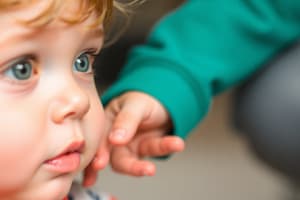Podcast
Questions and Answers
What is the main purpose of the Strange Situation procedure?
What is the main purpose of the Strange Situation procedure?
- To assess the cognitive development of infants
- To measure physical growth in children
- To determine the emotional intelligence of toddlers
- To evaluate the quality of attachment in 1-2-year-olds (correct)
Which attachment classification describes infants who show little distress at separation and avoid contact with the caregiver upon return?
Which attachment classification describes infants who show little distress at separation and avoid contact with the caregiver upon return?
- Insecure-Resistant
- Insecure-Disorganized
- Insecure-Avoidant (correct)
- Secure
What behavior is characteristic of infants classified as Insecure-Resistant?
What behavior is characteristic of infants classified as Insecure-Resistant?
- Being easily soothed by the caregiver upon return
- Mixing proximity-seeking and angry behaviors upon return (correct)
- Showing no distress at separation
- Becoming friendly with strangers
What do infants classified as Disorganized/Disoriented typically display?
What do infants classified as Disorganized/Disoriented typically display?
Which cultural variation is mentioned in the text regarding attachment classifications?
Which cultural variation is mentioned in the text regarding attachment classifications?
According to Attachment Theory, which hypothesis suggests that most infants form a secure attachment relationship?
According to Attachment Theory, which hypothesis suggests that most infants form a secure attachment relationship?
According to Harlow's research, what did the infant monkeys prefer?
According to Harlow's research, what did the infant monkeys prefer?
Which of the following is NOT one of Bowlby's phases of attachment?
Which of the following is NOT one of Bowlby's phases of attachment?
What is the purpose of attachment, according to the text?
What is the purpose of attachment, according to the text?
Which of the following is NOT an infant's attachment-related behavior mentioned in the text?
Which of the following is NOT an infant's attachment-related behavior mentioned in the text?
Which theory did Bowlby's Attachment Theory draw from?
Which theory did Bowlby's Attachment Theory draw from?
Which of the following methods is used to assess individual differences in attachment?
Which of the following methods is used to assess individual differences in attachment?
What character traits describe bold children?
What character traits describe bold children?
How do shy children typically respond to new activities?
How do shy children typically respond to new activities?
What does adaptability refer to in terms of temperament?
What does adaptability refer to in terms of temperament?
What characterizes children with extreme intensity?
What characterizes children with extreme intensity?
In terms of rhythm, what does it mean if a child's biological cycles are predictable?
In terms of rhythm, what does it mean if a child's biological cycles are predictable?
How do children with low persistence typically react to challenges?
How do children with low persistence typically react to challenges?
How does parent-child goodness of fit affect the relationship?
How does parent-child goodness of fit affect the relationship?
What might be a common misconception about difficult children?
What might be a common misconception about difficult children?
How does child temperament influence parental behavior?
How does child temperament influence parental behavior?
What is a potential criticism of the study by Thomas and Chess (1986)?
What is a potential criticism of the study by Thomas and Chess (1986)?
Which method helped refine parental reports in modern measurement techniques?
Which method helped refine parental reports in modern measurement techniques?
What type of bias is associated with all data being from parental reports?
What type of bias is associated with all data being from parental reports?
What was one of the key findings from the study by Johnson, Dweck & Chen (2007)?
What was one of the key findings from the study by Johnson, Dweck & Chen (2007)?
Which of the following is NOT a potential benefit of secure attachment in later development?
Which of the following is NOT a potential benefit of secure attachment in later development?
Based on the information provided, what did the longitudinal study by Kochanska (2001) find?
Based on the information provided, what did the longitudinal study by Kochanska (2001) find?
Which of the following is NOT considered an attachment behavior?
Which of the following is NOT considered an attachment behavior?
Based on the information provided, what can be concluded about the development of attachment quality?
Based on the information provided, what can be concluded about the development of attachment quality?
What is the main focus of the section titled 'Outline' in the text?
What is the main focus of the section titled 'Outline' in the text?
Describe the characteristics of shy children in terms of approach and withdrawal.
Describe the characteristics of shy children in terms of approach and withdrawal.
What is the characteristic behavior of adaptive children when faced with changes in daily routine?
What is the characteristic behavior of adaptive children when faced with changes in daily routine?
Explain how children with extreme intensity react emotionally.
Explain how children with extreme intensity react emotionally.
What does rhythm refer to in terms of child temperament?
What does rhythm refer to in terms of child temperament?
How do mellow children typically react emotionally?
How do mellow children typically react emotionally?
Explain the concept of persistence in child temperament and how children with low persistence respond to challenges.
Explain the concept of persistence in child temperament and how children with low persistence respond to challenges.
What are the key components of infants' models of attachment, as discussed by Johnson, Dweck & Chen (2007)?
What are the key components of infants' models of attachment, as discussed by Johnson, Dweck & Chen (2007)?
How did the longitudinal study by Kochanska (2001) differentiate between securely attached and insecurely attached children?
How did the longitudinal study by Kochanska (2001) differentiate between securely attached and insecurely attached children?
What is temperament, and what do researchers generally agree upon about it?
What is temperament, and what do researchers generally agree upon about it?
What are the 9 dimensions of temperament outlined in the New York longitudinal study?
What are the 9 dimensions of temperament outlined in the New York longitudinal study?
What is the concept of 'goodness of fit' in relation to temperament?
What is the concept of 'goodness of fit' in relation to temperament?
How does attachment quality vary according to the Competence Hypothesis Individ.Diff?
How does attachment quality vary according to the Competence Hypothesis Individ.Diff?
Describe the behavior of infants classified as Insecure-Avoidant.
Describe the behavior of infants classified as Insecure-Avoidant.
What are the key characteristics of infants classified as Insecure-Resistant?
What are the key characteristics of infants classified as Insecure-Resistant?
Explain the behavior displayed by infants classified as Disorganized/Disoriented.
Explain the behavior displayed by infants classified as Disorganized/Disoriented.
What is the Secure attachment classification known for in infants?
What is the Secure attachment classification known for in infants?
What are the cultural variations mentioned in the text regarding attachment classifications?
What are the cultural variations mentioned in the text regarding attachment classifications?
Discuss the hypotheses proposed by Attachment Theory according to the text.
Discuss the hypotheses proposed by Attachment Theory according to the text.
How do children with high activity levels typically behave?
How do children with high activity levels typically behave?
What characterizes children with low activity levels?
What characterizes children with low activity levels?
What does it mean if a child has a high sensory threshold?
What does it mean if a child has a high sensory threshold?
How do children with low distractibility typically focus?
How do children with low distractibility typically focus?
What is the response of persistent children to challenging problems?
What is the response of persistent children to challenging problems?
How do children with low persistence typically approach challenging problems?
How do children with low persistence typically approach challenging problems?
How does child temperament influence how parents behave with their children?
How does child temperament influence how parents behave with their children?
What are some criticisms of the study by Thomas and Chess (1986)?
What are some criticisms of the study by Thomas and Chess (1986)?
How have modern measurement techniques refined parental reports?
How have modern measurement techniques refined parental reports?
What is the relationship between parent-child goodness of fit and the parent-child relationship?
What is the relationship between parent-child goodness of fit and the parent-child relationship?
How do parents typically respond to difficult children in terms of effectiveness and behavior?
How do parents typically respond to difficult children in terms of effectiveness and behavior?
What potential biases are associated with all data being from parental reports?
What potential biases are associated with all data being from parental reports?
Flashcards are hidden until you start studying
Study Notes
Attachment Theory
- Attachment: an emotional connection between individuals, serving as a secure base for exploration and a safe haven in times of distress
- History of Attachment Theory:
- Freud's Psychoanalytic Theory: importance of early parent-child relationships
- Harlow's reaction to Drive Reduction Theory: empirical test of whether the mother-child relationship develops from satisfied needs
- Bowlby's Attachment Theory: draws on Psychoanalytic theory, Ethology, and Harlow's research
- Phases of Attachment (Bowlby):
- Preattachment (birth to 6 weeks)
- Attachment in the making (6 weeks to 6-8 months)
- Clear-cut attachment (6-8 months to 18 months-2 years)
- Reciprocal relationships (2+ years)
Infant's Attachment-Related Behaviors
- Separation anxiety: distress when caregiver leaves
- Stranger anxiety: fear of unfamiliar adults
- Social referencing: looking to caregiver when unsure
- Greetings: reaction to caregiver after separation
- Secure base behavior: using caregiver as a "base of operations" to explore
Individual Differences in Attachment
- Methodologies:
- Strange Situation Procedure
- Laboratory Procedure
- Attachment Q-Set
- Naturalistic Observation
- Quality of attachment varies as a product of both parents and children
- Temperament influences how parents behave with their children
Temperament
- What is Temperament?
- 9 Dimensions of Temperament:
- Activity
- Adaptability
- Distractibility
- Intensity
- Persistence
- Rhythm
- Sensory threshold
- Temperament types:
- Bold children: high on approach, low on withdrawal
- Shy children: low on approach, high on withdrawal
- Goodness of fit between child and parent:
- Positive if parents work with children
- Negative if parents work against children
Hypotheses of Attachment Theory
- Universality Hypothesis: all infants form an attachment
- Normativity Hypothesis: most infants form a secure attachment relationship
- Sensitivity Hypothesis: individual differences in attachment predict future competence
Studying That Suits You
Use AI to generate personalized quizzes and flashcards to suit your learning preferences.




